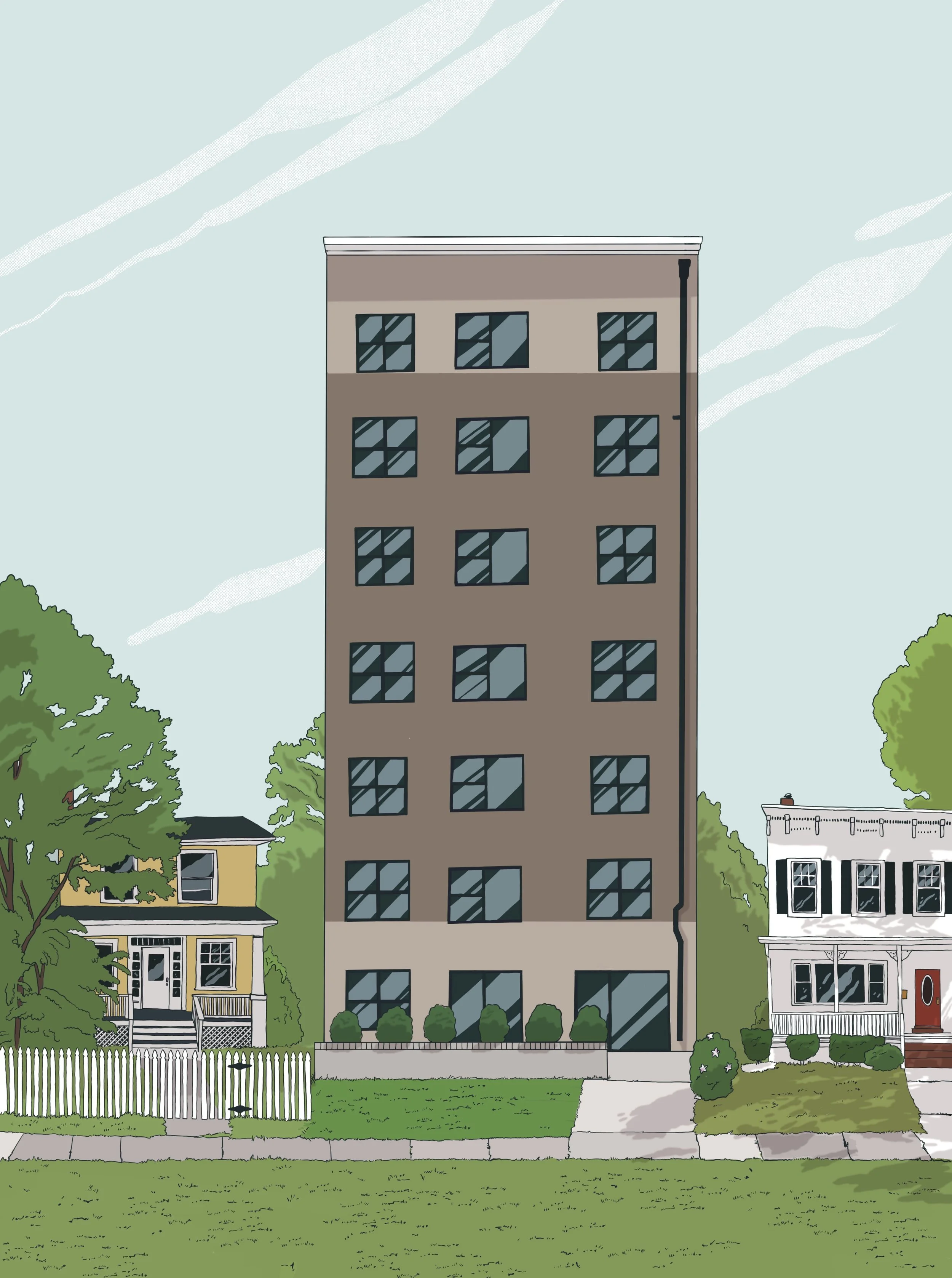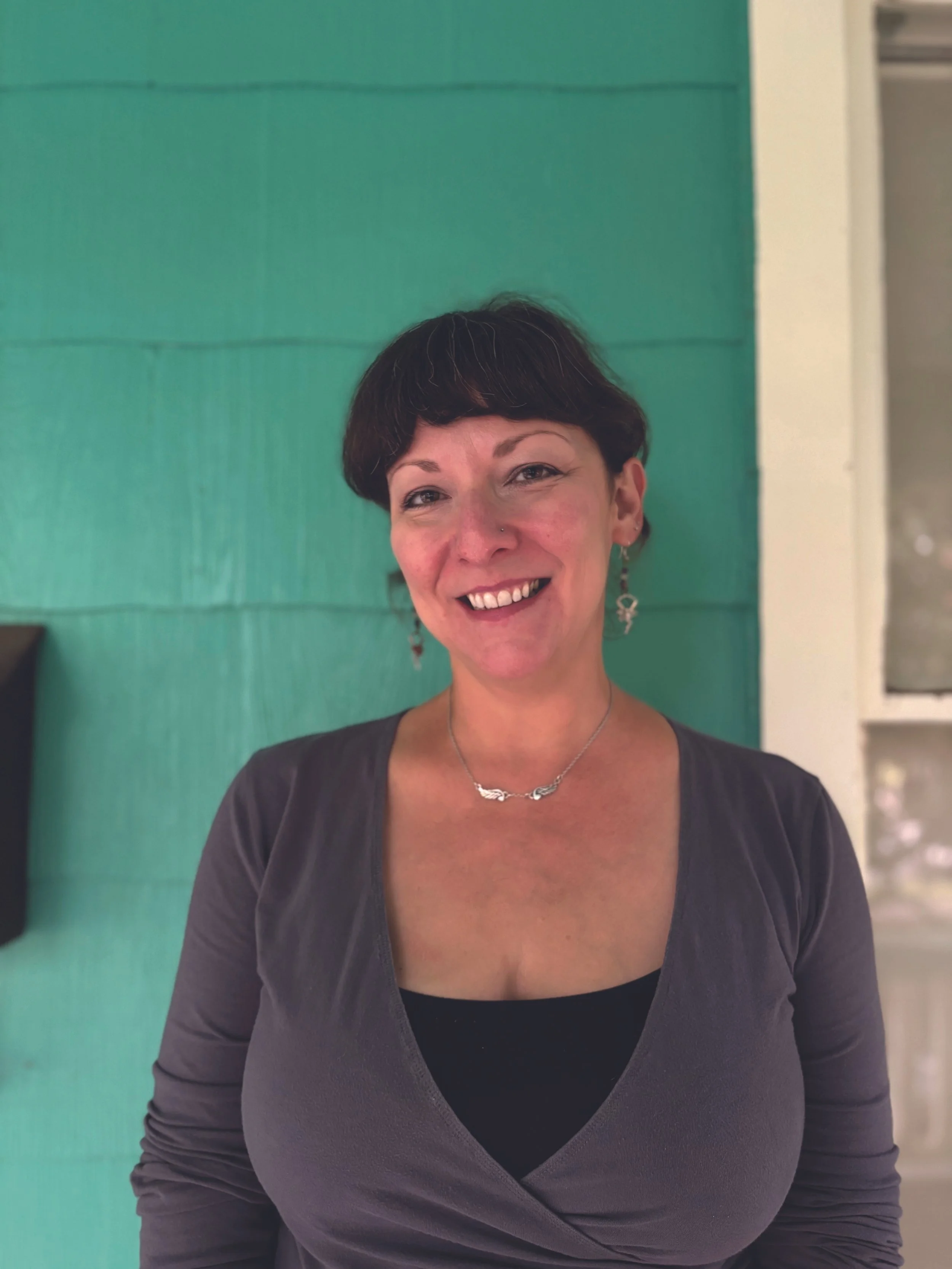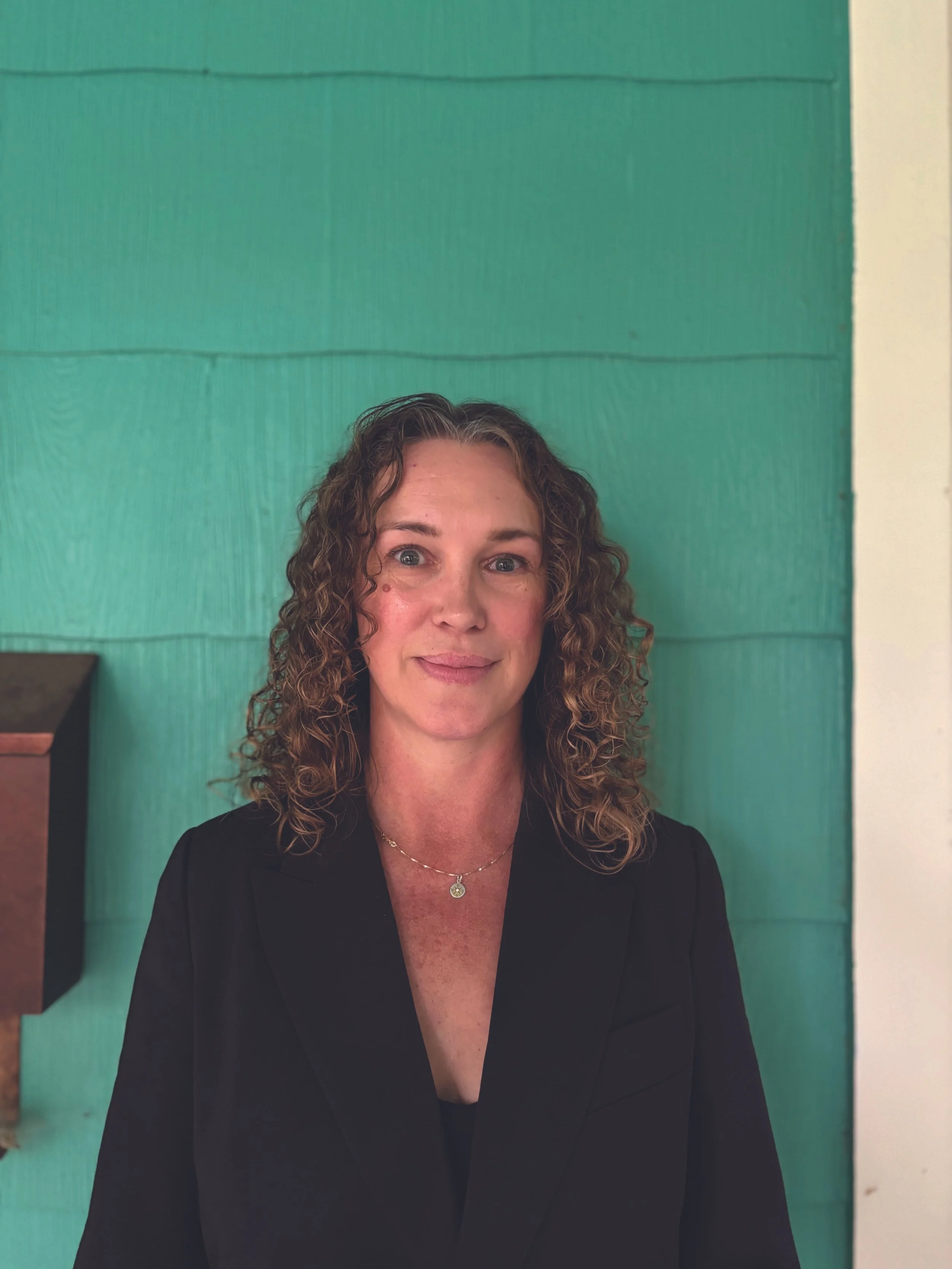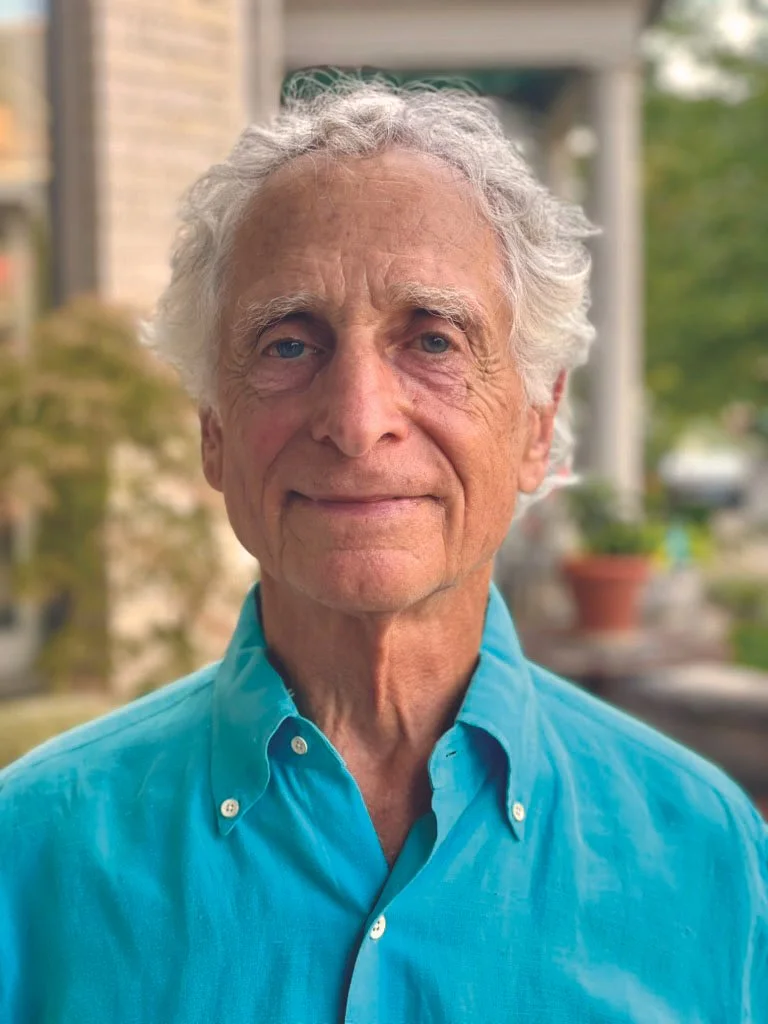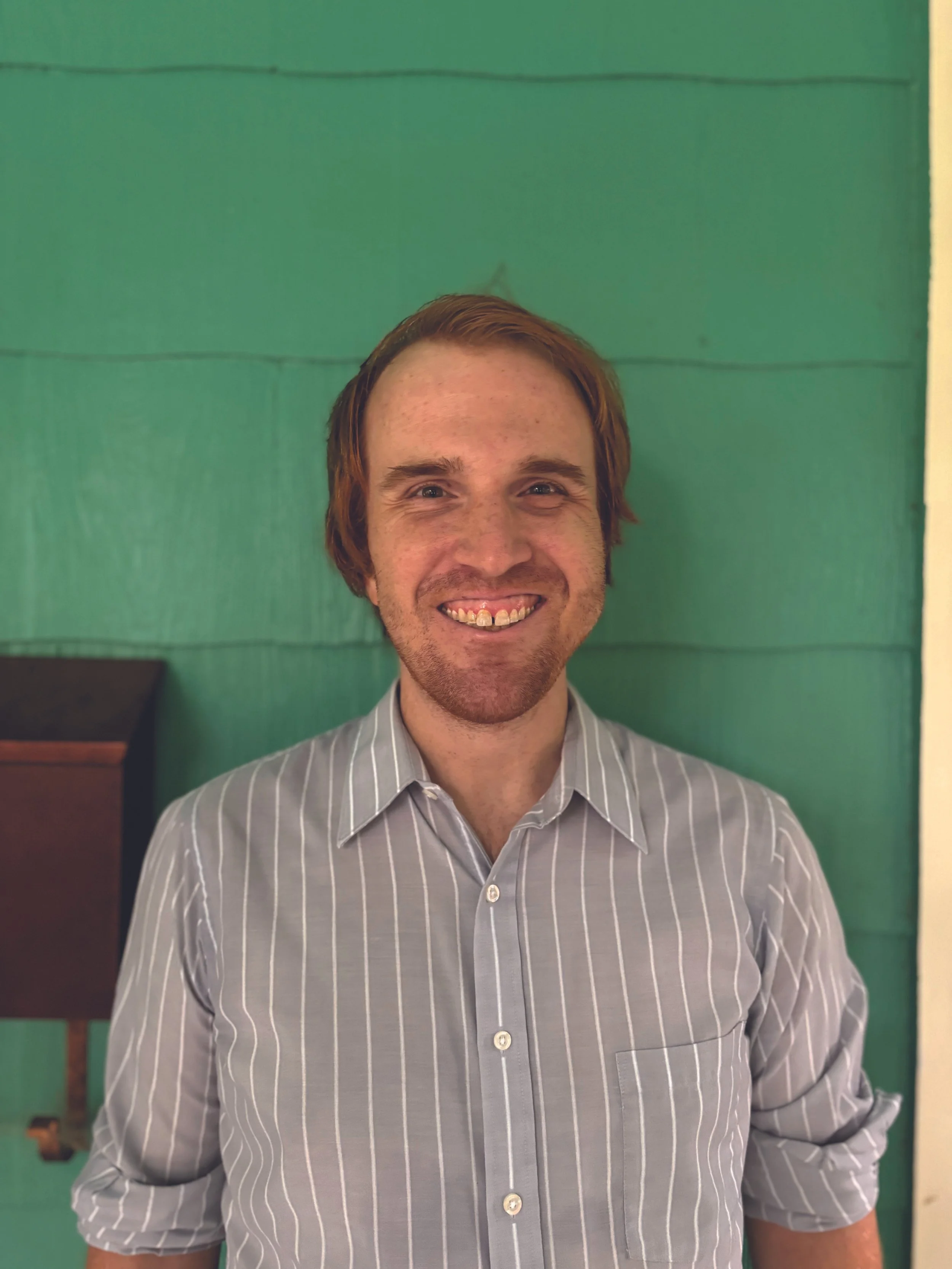Code Refresh
by Charles McGuigan 10.2025
The divisiveness in America today rivals every other era in our history outside of that contentious decade that ended with the beginning of the Civil War. And here in Richmond, the former capital of the Confederacy, there is a veritable canyon dividing people over the adoption of a new code that would essentially rezone all 77,000 parcels of land that make up the city. Code Refresh, as it’s known, is an attempt to update zoning regulations so that they conform with Richmond 300, the city’s comprehensive plan adopted five years ago during Levar Stoney’s tenure as mayor. Some residents are worried that this new code, in one fell swoop, would rezone every square inch of the city and preclude input from the citizenry on zoning matters.
Even in relatively civil circles where people are simply discussing the code, the tempers of some individuals can quickly rise, crushing the possibility of meaningful dialogue. Those who oppose the plan are sometimes called NIMBYs; those in favor of it are frequently dubbed YIMBYs. In both instances these terms are used pejoratively. The former suggests close-mindedness and an unwillingness to alter the status quo, and a desire to maintain homogeneous neighborhoods. The latter hints at a naive and wide-eyed acceptance of unchecked growth driven by the greed of certain developers out to make a quick profit with no regard for the health of the city.
By their very nature, cities are organic entities, and if they are robust, their appearance is altered over time. Cityscapes change from one generation to the next. And reactions to those changes may differ greatly. Where an older person might lament the demolition of a favorite music venue from her youth, someone much younger might rave about the new mixed use building that took its place. Nostalgia can sometimes stymie growth and impede urban evolution.
On the other hand, at times, some developers tear down buildings that have both historic and aesthetic significance, or could simply be repurposed. Some of these developers come from other regions and do not seem to be vested in the overall well-being of the city. Maximum profit seems to be their sole motive, according to some folks.
Earlier this week, a great iron claw reduced an iconic structure on MacArthur Avenue’s business strip in Bellevue to a pile of rubble in a matter of hours. (Coincidentally, on the same day, just a hundred miles to the north, identical iron claws began their desecration of the White House.) Instead of revitalizing and adding on to the existing structure that housed Lauterbach Electric for decades, developers chose to tear it down and bury much of its remains in a landfill out in Rockville. Oddly, just across the street from Lauterbach, the same developers, in classic reuse form, recently renovated the old Bellevue Theatre which is now a mixed used structure housing retail shops and apartments.
Current zoning is unquestionably antiquated—the last comprehensive overhaul to the zoning ordinance dates back almost fifty years when America was celebrating its bicentennial. At that time white people were flocking to the suburbs in droves. Since then, things have changed significantly, yet the population today is still somewhat lower than it was in the early1950s.
One of the objectives of Code Refresh is to increase population density. But considering the city’s aging infrastructure and other factors, some residents think this might be putting the cart before the horse. Remember what happened last January when our entire water system failed? And then there are the poorly maintained streets pocked with potholes, a host of beleaguered schools, and so on. This, too: With increased density there are those who wonder if the city will become something other than it is, losing its charm, its soul, and the other impalpable qualities that make Richmond such a desirable place to call home—the very reason so many people have moved here in recent years from places like Arlington County, where population density has soared over the last twenty years.
NORTH of the JAMES recently reached out to a number of civic association presidents and asked their take on Code Refresh. We appreciate the time they have devoted to studying the Code Refresh and responding to our request. This is what they had to say:
Carra Rose, president Battery Park Civic Association.
BATTERY PARK CIVIC ASSOCIATION, 800 dwellings
Carra Rose
“As a long time resident of Battery Park I have been very engaged with my community and have had the pleasure of participating and serving this community in various ways. I am currently the president of the Battery Park Civic Association and being in this leadership position for the community have attended and participated in numerous discussions and facilitated events that work with the city administration. I was able to be one among hundreds of other community members of the Richmond 300 working group that started defining the plan beginning in May 2017. Since then I have continued to stay engaged with the plan and the process as they have rolled out each phase, participating in the listening sessions, catching up at other information sessions, reviewing the updates of Richmond 300 as well as the Code Refresh over the past eight years.
“In the past year we have had various officials from the city come to talk with our civic association and discuss what the plan is for Code Refresh, how people can engage and where to access the information. We have ensured that all of our minutes are accessible on our website as well as try to keep the community members informed of events via social media. As the officials and members continue to roll out this phase of Code Refresh and gain more community input it is important for the community to stay as informed as possible.
“I believe that they are doing a very good job with the communication efforts and are taking the community feedback into account. I believe that these efforts will be beneficial to the city as a whole. The update to our zoning codes are necessary to build a thriving city that is equitable for everyone, by stimulating positive and inclusive growth, using it as a tool to encourage housing affordability, and setting in motion efforts to bring communities back together that were carved up by redlining.
“While this is a human driven endeavor and we are not without fault, I do believe that this Code Refresh effort has been and continues to be inclusive and engaging for the city residents. I am slightly concerned that certain members who serve on these different committees have varying motivations to do so and we should be cautious to ensure that those motivations aren't going to promote a quid pro quo situation that will result in deals for developers that aren't in line with the city's vision. That being said, I do believe that there is relatively good coverage and engagement surrounding this ongoing plan and the community does have oversight.
“I look forward to continuing working with the community and city to help fully define what the results of this process will look like for the future of Richmond.”
Catherine Willis, president Bellevue Civic Association.
BELLEVUE CIVIC ASSOCIATION, 1,200 dwellings
Catherine Willis
“The Bellevue Civic Association, like many of our peer neighborhood associations across Richmond, recognizes the importance of the City’s Code Refresh process in shaping future development and daily quality of life. We’ve worked to share accurate information and encourage resident engagement throughout the process. Our recent survey drew 120 responses—roughly 10% of Bellevue residents—and while not reflective of the neighborhood as a whole, those who responded expressed clear preferences: 92% supported limiting mixed-use buildings to two or three stories, 82% opposed RD-C zoning in the southeast quadrant, and 85% opposed allowing duplexes plus ADUs by right unless one unit is owner-occupied. These results highlight a desire to preserve Bellevue’s scale and character while supporting balanced, thoughtful growth.”
Jerome Legions, president Carver Area Civic Improvement League.
CARVER AREA CIVIC IMPROVEMENT LEAGUE, 17,000 dwellings
Jerome Legions
“The Carver Community has always made way for growth and development for housing and economic development. This community can be considered one of the best examples of density that includes equitable housing and home ownership and economic development in Richmond. There are high density dwellings for low income residents, luxury condos, single family homes, net zero housing, student housing, etc.
“With the Richmond Planning Department/Commission working on plans to increase density through rezoning efforts, one concern is how much of, if any, Carver architectural vernacular will remain if not protected. It seems that the only way to keep as much of the historical value is to code the Cultural Heritage Stewardship Plan into the rezoning. Without the preservation component, the concern is that developers ‘by-right’ can erase the character of the neighborhood which would include the Historic Industrial District, and the Historic Residential District, and the Hartshorn Homes. Currently the only Old and Historic areas are being considered for historic preservation. If buildings are listed on National or State registers of historic sites there should be strong language in the rezoning plan to preserve locations and sites.
“The SUP process which is being reduced by the implementation of the Code Refresh will take community engagement out of community development. The problem is not the community's involvement with a SUP, the problem is getting the SUP through City Hall. For the last twenty years when Carver and developers are engaged, the project ends up being a win-win for the developer and the community. The biggest developer in Carver is VCU, however, there has always been engagement between Carver and VCU as the University develops its master plan. That process started with Dr. Trani, who created a MOU between Carver and VCU.
“Another concern is - how will increasing density affect community engagement? Carver is roughly 70/30 renters/homeowners. This is not an issue of the planning department/commission and the rezoning efforts; it will however, become a residual issue once the plan has been adopted and developers start project development.
“In our community renters rarely join the civic association, which may be due to the fact that their plan is to live in the neighborhood for no more than one to three years.
“In reviewing the rezoning plans, the Planning department/commission has recommended some elements that already exist: zero lot line dwellings. If I had my way, all of Carver would be zero lot line which would keep in line with the character of most of the community, before some of the wooden dwellings were demolished through neglect. This would give new structures greater lot coverage without lessening the green space in front and rear yards through greater lot coverage.”
Susan Rebbilot, president Ginter Park Civic Association.
GINTER PARK RESIDENTS ASSOCIATION, 3,000 dwellings
Susan Rebillot
“The Ginter Park Residents Association understands the need for the existing zoning ordinance to be revised in accordance with the objectives set forth in the Richmond 300 Master Plan. The GPRA generally supports increased opportunities for commercial uses that encourage the establishment of local and small businesses, a diversity of housing types, and options for housing that are truly affordable. Aside from specific district regulations, GPRA’s main objections to Code Refresh Draft 1 are related to the flawed process, which has resulted in a flawed code rewrite. Our most salient points are as follows:
“The viewpoints expressed by the Zoning Advisory Committee (ZAC) appear to be primarily those of the property development industry rather than diverse perspectives from a broad sampling of stakeholders, especially property-owners that represent neighborhood-specific perspectives. The ZAC selection process clearly favored development interests, with 12 of the original 18 members from the development industry.
“The city failed to provide robust outreach to inform residents of all neighborhoods about the proposed draft. This limited opportunities for widespread and diverse public engagement resulted in a small percentage of Richmonders with awareness, understanding and participation in the process. The reliance on an ‘open house’ model of meeting, post it notes, and comments to be entered on a website are exclusionary, non-transparent, non-verifiable and designed to dilute inclusive, public, robust conversation.
“The process employed by the city was a blanketed, one-size-fits-all approach rather than a strategic, targeted, and incremental approach that would first focus on corridors and areas of best opportunity for development, redevelopment, and densification before targeting all neighborhoods city-wide.
“The tools necessary to ensure that goals are met for affordable housing and anti-displacement are lacking. This is likely to result in an insignificant number of new affordable units and losses of existing affordable housing as has occurred in other U.S. cities which have undertaken similar efforts. Chamberlayne Avenue and its 1100 naturally occurring affordable housing (NOAH) units are just one example of the many at-risk units.
“There are significant inconsistencies and conflicts between Draft 1 of Code Refresh and the Richmond 300 Plan with regard to neighborhood preservation and sustainability, as well as the failure of the Planning Commission to provide a timely recommendation to City Council regarding the adoption of the Cultural Heritage Stewardship Plan, which contains protective measures for the preservation of existing neighborhoods and historic resources.
“‘By-right’ development provisions provide for severe erosion of the democratic principle of public review of proposed non-conforming uses through the Special Use Permit (SUP) process thereby diluting the ability of residents to shape projects in their neighborhoods.”
Benjamin Ross, president Ginter Park Terrace Association.
GINTER PARK TERRACE ASSOCIATION, 150 dwellings
Benjamin Ross
“Many neighborhood associations are concerned about the outcome of the Code Refresh activity that the city is currently pushing through. One major concern is the possibility of new residential buildings being constructed in historic established communities. Many of these communities possess an architectural style that reflects the time period in which the community was established, often around the turn of the century and early 20th century. In Ginter Park Terrace, for example, the majority of the architecture is American Foursquare, Colonial, Dutch and Tudor Revival. The concern is - will the architecture of the new residential buildings be in harmony with the existing architecture of the established neighborhoods?”
Jonathan Jackson, president Hermitage Road Historic District.
HERMITAGE ROAD HISTORIC DISTRICT, 48 dwellings
Jonathan Jackson
“As president of the Hermitage Road Historic District, I appreciate the process the City has taken to gather community input on the Code Refresh in a transparent and user friendly process and look forward to seeing the community input integrated into the next round of drafts.”
Danielle Leek, president Highland Park Neighborhood Association.
HIGHLAND PARK NEIGHBORHOOD ASSOCIATION, 6700 dwellings
Danielle Leek
“When the City asked for comments on the Code Refresh draft, Highland Park residents came together to discuss the update and give feedback to the committee and our 6th district Councilwoman, Ellen Robertson. Here is what I learned:
“Highland Park neighbors are not opposed to zoning changes. Many want to update their homes to make changes or add ADU’s. They loathe the current SUP process. If the Code Refresh makes that process better, they are excited about it. They think Highland Park has been left out of new development opportunities. Current codes limit our one commercial area with restrictions on building height and usage.
“Neighbors also think the Code Refresh is confusing and doesn’t keep their future in mind.
“We collected questions about the draft code and sent those forward to the Councilwoman. The three most frequently asked questions were: Why is it so hard to put comments on this d&6! Map? How do you know that the comments are coming from people who live in our neighborhood? And how will you make sure the City can support all the new growth with the right services like trash and police and traffic pattern changes?
“So far, we still haven’t gotten these answers.
“People also had many specific questions - like ‘what does MX-3’ mean? Or ‘what will happen at X intersection?’”
“Our Councilwoman stepped up to help residents understand these details. She invited any resident to join a bus tour where we visited different parts of the neighborhood and listened to developers explain what new building is happening, and what they are seeking to build. Then, we heard from Planning Department representatives about how the Code changes would specifically impact that location in the future.
“The Councilwoman was very interested in hearing from long-term residents. Multiple times, she explained that even though the changes happening in Highland Park will bring thousands of new neighbors, her concern is for those who have already lived in the neighborhood for decades.
“Afterward, all of the neighbors who joined the tour unanimously agreed that they felt more knowledgeable and informed about the draft plan. Personally, I feel more confident explaining how changes can shape Highland Park. We are all so thankful for the well-designed tour and experience.
“Yet, like everything in Richmond, the history of the Highland Park Neighborhood Association is rich, fascinating, and complicated. (Even the name of the Association is a contentious source of debate!)
“Using 2023 Census data we estimate approximately 6700 households are currently located in our Association’s boundaries. That number is a 2000+ increase in the number of households since 2020. The tensions that come with that growth are real, and so are neighbors’ concerns that their voices and interests were not well-represented by the current Code development process.
“Residents in Highland Park will be looking to see how the new members added to the Advisory Board help give more weight to community interests. We also want the Board to tell us how our comments, from our neighbors, have been incorporated into the next draft of the Code.”
HISTORIC RICHMOND
Cyan Crump, executive director
“We have been following the Code Refresh closely as a continuation of the Richmond 300 Master Plan process, with which we were deeply engaged. Throughout that process, as advocates for density without demolition, we have supported the "Big Move” of re-writing the zoning ordinance to a form-based code to improve health, resiliency, and access. We have also been consistent in our belief that any zoning changes or revisions must include greater transparency and opportunities for public participation. To that end, Historic Richmond would like to make the following recommendations:
“The existing City Old and Historic Districts (COHDs) and Design Overlay District (DOD) should be transferred onto the new zoning map. These protections, initiated at the request of the neighborhoods, are currently the only form of demolition-review and regulatory protections in our city. COHDs and DODs support and protect our unique historic neighborhoods, Telping them to retain what mal‹es them special and ensuring that our future doesn't come at the expense of our past (and present).
“The process for designating new districts should be the same bottom-up community-driven approach as is found in the current zoning ordinance. The existing COHDs and DOD were created with clear and overwhelming support from property owners.
“Historic Richmond encourages you to consider adjusting the DOD process to incorporate the public notice and public hearing provisions currently associated with COHDs. These provisions will provide the transparency and public engagement that the community is requesting.”
Jonathan Marcus, past president Historic West Grace Street Association.
HISTORIC WEST GRACE STREET ASSOCIATION, 73 dwellings
Jonathan Marcus
“The citywide rezoning of Richmond, called Code Refresh, will shape the features, function, and character of our city permanently, with the potential to enhance Richmond’s growth and newfound status as a destination city.
“But citizens throughout the city who are in favor of growth and eager to facilitate this once-in-a-generation opportunity to guide Richmond’s continuing evolution are concerned that this opportunity is being compromised by a combination of factors:
“The chief concern is the composition of the Zoning Advisory Council (ZAC). All 17 members of ZAC are chosen or approved by the Chair of the Planning Commission, a developer who has been appointed to that powerful position continuously for twenty years. His conflicts of interest are multiple, and the members of ZAC are almost all developers or working in adjacent industries, such as finance or lobbying.
“It is important to note that developers certainly have a place on a rezoning body, but a body made up almost exclusively of development interests cannot possibly serve all stakeholders in our city, which is both culturally rich and multiply challenged.
“Other concerns include:
“Richmond 300 is the land use plan required by state code as the basis for any rezoning in a municipality. But Code Refresh ignores primary requirements codified in Richmond 300, including environmental protections, housing affordability, historical preservation, and more. We have asked the Planning Department for a list of these stipulations in Richmond 300 that are not addressed in Code Refresh, but no clear answers to that simple question have been provided.
“A basic fallacy on which Code Refresh is being justified is that density creates affordability. If so, New York would be the cheapest city in the country, and the Fan would be the cheapest neighborhood in Richmond. But they are among the most expensive.
“Another fallacy is that the affordable housing crisis is a matter of supply and demand – so, build more housing! Richmond and the region do have ample housing above approximately $500,00 (an estimate), but we suffer from a severe shortage for residents in important but relatively low paying jobs, such as healthcare, education, law enforcement, service workers, and more, who cannot afford a $500,00 house. More supply will not serve these thousands of workers simply because builders cannot sell houses for less than what it costs to build.
“Code Refresh masquerades as a solution to affordability and a housing shortage, but it is in fact just a zoning overreach to allow developers freedom that does not serve the common good.
“Again, please note: we are in favor of growth based on the collaboration between developers and all other stakeholders.
“Code Refresh also ignores the Cultural Heritage Stewardship Plan, a document that details how we can grow the city while protecting the history and culture, facets of the many that make Richmond such an attractive destination.
“We would like to see either a new ZAC composed of developers as well as representatives of all the critical stakeholders, including environmentalists, law enforcement, preservationists, transit advocates, and neighborhood leaders. After all, it’s the urban pioneers – not the city planners – who recognized what we have here and rebuilt the city brick-by-brick and block-by-block. All these stakeholders can and should work together to enhance Richmond’s ongoing evolution.”
Zach Hanson, president North Central Civic Association.
NORTH CENTRAL CIVIC ASSOCIATION, 700 dwellings
Zach Hanson
“The North Central Civic Association covers an approximately 2.2 square mile area of Northside between Griffin Avenue to the west, North Avenue to the north and east, and Brookland Park Boulevard to the south.
“Overall, there is an amicable split of opinion in the neighborhood. Most people agree with the core objective of reducing the cost of housing by providing a diverse array of housing choices and moderately increasing density. However, some of the older residents are opposed or skeptical that the rezoning would lead to the outcomes it suggests. Parking is the one of the key issues people cite when discussing how density will affect BPB. People are also not quite convinced the rezoning will help the housing crisis.
“On the other hand, other people support changes because they believe it would lead to more housing being built which would help reduce housing costs or reduce the rate at which it would have increased otherwise. This along with the associated growth in economic activity would lead to the equity and sustainability goals of Richmond 300. I would say the room is roughly in favor of the plan, but most people I've spoken to about this issue in my neighborhood are homeowners.”
Valerie L'Herrou, president Oregon Hill Civic Association.
OREGON HILL NEIGHBORHOOD ASSOCIATION, 600 dwellings
Valerie L’Herrou
“The Oregon Hill neighborhood has long felt ‘under siege.’ While neighbors have different opinions about many aspects of the ‘Code Refresh’ zoning process and proposals, the feeling of being unheard and powerless is shared.
“Oregon Hill is a densely populated urban neighborhood, consisting of mostly attached houses — if detached, arms-width apart, and ADUs are common. Many homes are duplexes, and/or occupied by multiple students or young professionals. Most are historic homes, many closing in on 150 years old, and the neighborhood has a distinctive streetscape and was once much larger than it is today. Many forces have pushed the neighborhood into a smaller footprint. The section next to Tredegar Ironworks was destroyed long ago. In the 1970s, the expressway ripped out many houses and businesses. Later, when Belvidere was widened, several more blocks were razed.
“In the 1980s, VCU developed a plan to level the entirety of Oregon Hill. My own 1880s row house, under the VCU plan, would have been a soccer field. In the late 1990s, Ethyl Corporation (now New Market) bought and razed several blocks of houses facing the river.
“Recently, the neighborhood was further shrunk by the city, which no longer recognizes our northern-most blocks, which now apparently belong to VCU. Until this summer, people entering the neighborhood from West Cary Street were greeted by banners stating ‘Welcome to Oregon Hill.’ The Oregon Hill Historic District is listed on the Virginia Landmarks Register and the National Register of Historic Places with W Cary St as its northern boundary. But now, the city says the northern half of the neighborhood is no longer part of the neighborhood, and the ‘Welcome’ banners were removed by the city. (Be assured: all are welcome here, banners or no banners!)
“The city’s SUP process has served our neighborhood well. While it does not prevent by-right demolitions, we can negotiate with builders doing in-fill projects to preserve the neighborhood’s visual character. Our concern, which is shared by Carver and Jackson Ward, is that more of these historic houses will be torn down and replaced with those quick-and-cheap apartment buildings we see everywhere.
“Many homes in Oregon Hill are “fixer-uppers” — which could be affordable; but, as throughout the city, many are bought by LLCs that do not maintain the buildings, simply extract rents while they wait for zoning changes to enable demolition and redevelopment of quick-built ‘luxury’ apartments that do not contribute meaningfully to affordable housing stocks.
“We’re proud of our locally-owned businesses, everything from restaurants to service and retail.
“Oregon Hill would welcome historic and cultural overlay districts and the creation of a demolition approval process, to prevent intentional ‘demolition by neglect’ and assure new construction will fit the neighborhood’s’ needs and cultures.”
Grady Hart, president Rosedale Civic Association.
ROSEDALE CIVIC ASSOCIATION, 525 dwellings
Grady Hart
“Most of what I hear about the Code Refresh seems to come from two camps: NIMBYs and (to a lesser extent) YIMBYs. But in my experience, most of my neighbors in Rosedale and residents I’ve talked to around the 3rd District and across the city fall somewhere in-between these two extremes.
“What I’m most interested in seeing and supporting is so-called incremental or “middle” housing, which usually comes from conversions of single family homes into duplexes, triplexes, and quadruplexes in neighborhoods where current housing is primarily single-family residential. As an early 30’s Millennial who was lucky enough to buy my first home in 2019, I recognize the difficulty that my friends and others who want to live in neighborhoods like mine have in finding something that works financially. Allowing by-right “middle housing” like duplexes - with common sense restrictions to protect neighborhoods from big investors, like requiring the preservation of an existing dwelling unit in order to build/convert a second or third unit - would do a lot to increase access to some of our most popular neighborhoods. I would really love to see the City facilitate this by providing small grants to homeowners who build an additional unit on their lot and rent it to long-term tenants, especially those using affordable housing vouchers.
“I also hear a lot of single-family homeowners using affordable housing as a talking point for opposing increased density (i.e., “I will only support it if it’s designated as affordable housing”). About two years ago in Rosedale, a developer approached us about adding 80 designated affordable housing units immediately adjacent to the neighborhood, and our residents voted to approve the development after we hosted an open forum to share information and answer questions. I am proud to live in a neighborhood that collectively agreed to support affordable housing right “in our backyard,” and I challenge other relatively wealthy neighborhoods to use the same energy I see going into their Code Refresh efforts to seek opportunities to do the same.”
Tammy Rose, vice president Westwood Civic League.
WESTWOOD CIVIC LEAGUE, 150 dwellings
Tammy Rose
“When you think about the changes that may occur in the City of Richmond, you can’t help but think about the differences between developers’ and residents’ ideas.
“While changes seem to be happening in historical neighborhoods, like my own community, the urgency to make sure our voices are heard is paramount. My neighborhood is one of those areas where history is rapidly disappearing. ‘Westwood’ is a community established by freed enslaved people after the Emancipation Proclamation. We were first in the County of Henrico (approximately 65 homes) and then, we, along with what is known as the ‘Westhampton area’ were purchased (annexed) by the City of Richmond. This part of the First District was known as the ‘Far Westend,’ as we are the farthest ‘west’ of the City of Richmond.
“Our neighborhood boundaries are one square mile (Patterson Avenue to Glenburnie Road to Stokes Lane to Dunbar Street, back to Patterson Avenue. Within this grid, are five more streets (Marian Street, Parrish Street, Horne Street, Park Avenue and Snowden Lane – all with historical significance.
“We are currently recognized as a R5 (residential) neighborhood but with Code Refresh, that would be changed to RD-B (Residential Detached Medium), which means that it would allow homeowners to have up to two units and one ADU on lot sizes up to fifty feet wide. The front of our neighborhood on Patterson Avenue and part of Glenburnie Road would be changed to MX-6, which would allow developers to build up to six-story residential, commercial or mixed-use buildings.
“Our neighborhood isn’t set up for this type of encroachment. We know that change will come to this community, but we have not received a traffic study or a small area study we requested. Our streets are narrow and we barely have space to move through or park on our streets. Most of our neighbors have more than one vehicle and to propose to add more structures to an already dense area is without care or thought for the people that are already in the neighborhood. We are looking for ways to preserve the history of some of the historic homes that are still standing in our community, to insure they are preserved and restored, if possible.
“Duplexes and other buildings will be a hindrance to an already crowded neighborhood.
“The lack of green spaces will decrease; emissions and heat spots will increase and the foot, cars, bike traffic will also increase. The City of Richmond wants to increase density, but not every neighborhood should be packed so much with all these different types of structures. Residents will no longer be able to enjoy the reason why they moved into a neighborhood in the first place!
“Lastly, we have seen a lot of new homes built, but at a price that isn’t affordable for most want-a-be new homeowners. My last point about the RVA Code Refresh is the SUP (Special Use Permits) process. To try and change it so that more neighborhoods won’t be able to fight against some of the things that they may want to build is bad for residents. We must have an avenue to dispute something that won’t be good for communities.”

